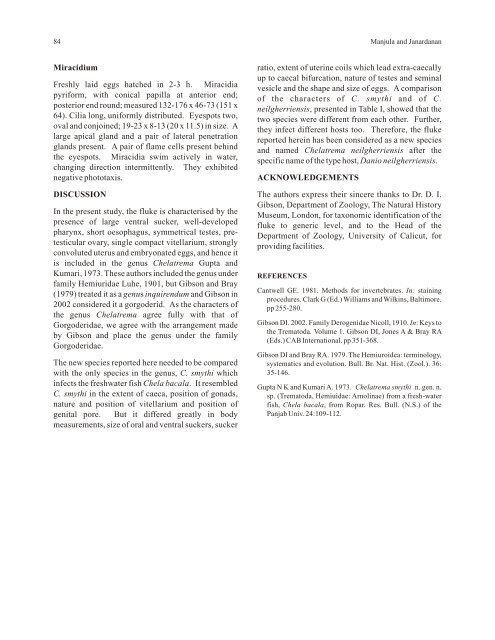PDF File - The Indian Society for Parasitology
PDF File - The Indian Society for Parasitology
PDF File - The Indian Society for Parasitology
Create successful ePaper yourself
Turn your PDF publications into a flip-book with our unique Google optimized e-Paper software.
84Manjula and JanardananMiracidiumFreshly laid eggs hatched in 2-3 h. Miracidiapyri<strong>for</strong>m, with conical papilla at anterior end;posterior end round; measured 132-176 x 46-73 (151 x64). Cilia long, uni<strong>for</strong>mly distributed. Eyespots two,oval and conjoined; 19-23 x 8-13 (20 x 11.5) in size. Alarge apical gland and a pair of lateral penetrationglands present. A pair of flame cells present behindthe eyespots. Miracidia swim actively in water,changing direction intermittently. <strong>The</strong>y exhibitednegative phototaxis.ratio, extent of uterine coils which lead extra-caecallyup to caecal bifurcation, nature of testes and seminalvesicle and the shape and size of eggs. A comparisonof the characters of C. smythi and of C.neilgherriensis, presented in Table I, showed that thetwo species were different from each other. Further,they infect different hosts too. <strong>The</strong>re<strong>for</strong>e, the flukereported herein has been considered as a new speciesand named Chelatrema neilgherriensis after thespecific name of the type host, Danio neilgherriensis.ACKNOWLEDGEMENTSDISCUSSION <strong>The</strong> authors express their sincere thanks to Dr. D. I.Gibson, Department of Zoology, <strong>The</strong> Natural HistoryIn the present study, the fluke is characterised by theMuseum, London, <strong>for</strong> taxonomic identification of thepresence of large ventral sucker, well-developedfluke to generic level, and to the Head of thepharynx, short oesophagus, symmetrical testes, pre-Department of Zoology, University of Calicut, <strong>for</strong>testicular ovary, single compact vitellarium, stronglyproviding facilities.convoluted uterus and embryonated eggs, and hence itis included in the genus Chelatrema Gupta andKumari, 1973. <strong>The</strong>se authors included the genus under REFERENCESfamily Hemiuridae Luhe, 1901, but Gibson and BrayCantwell GE. 1981. Methods <strong>for</strong> invertebrates. In: staining(1979) treated it as a genus inquirendum and Gibson inprocedures. Clark G (Ed.) Williams and Wilkins, Baltimore.2002 considered it a gorgoderid. As the characters ofpp 255-280.the genus Chelatrema agree fully with that ofGorgoderidae, we agree with the arrangement made Gibson DI. 2002. Family Derogenidae Nicoll, 1910. In: Keys tothe Trematoda. Volume 1. Gibson DI, Jones A & Bray RAby Gibson and place the genus under the family(Eds.) CAB International. pp 351-368.Gorgoderidae.Gibson DI and Bray RA. 1979. <strong>The</strong> Hemiuroidea: terminology,<strong>The</strong> new species reported here needed to be compared systematics and evolution. Bull. Br. Nat. Hist. (Zool.). 36:with the only species in the genus, C. smythi which 35-146.infects the freshwater fish Chela bacala. It resembledGupta N K and Kumari A. 1973. Chelatrema smythi n. gen. n.C. smythi in the extent of caeca, position of gonads, sp. (Trematoda, Hemiuidae: Arnolinae) from a fresh-waternature and position of vitellarium and position of fish, Chela bacala, from Ropar. Res. Bull. (N.S.) of thegenital pore. But it differed greatly in body Panjab Univ. 24:109-112.measurements, size of oral and ventral suckers, sucker










